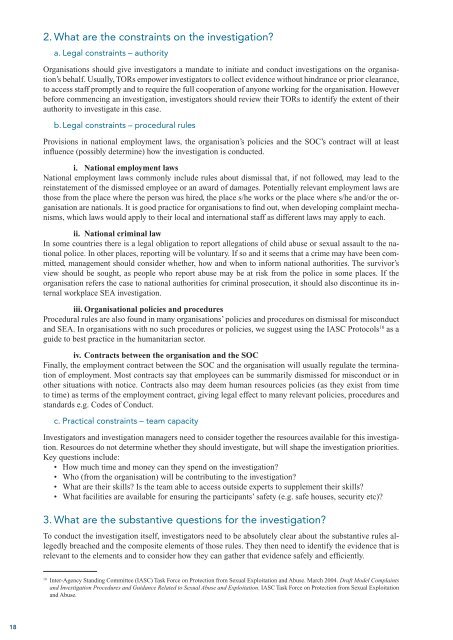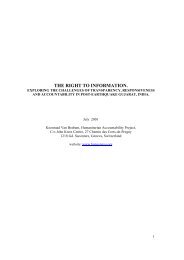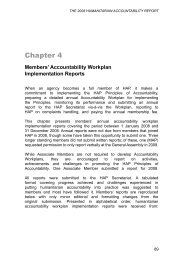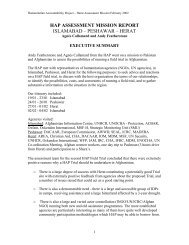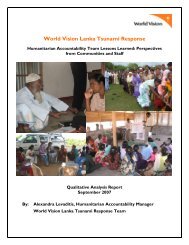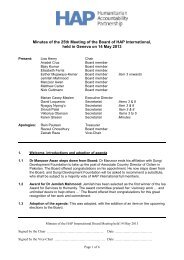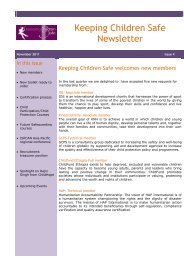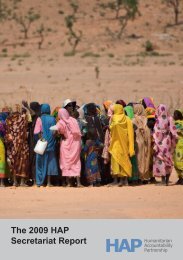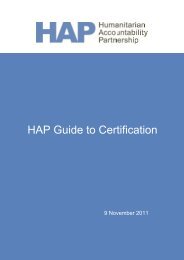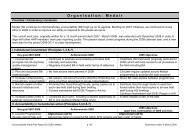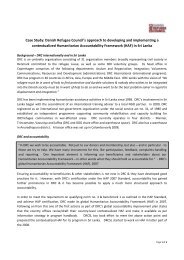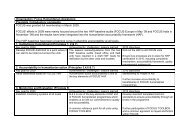Building Safer Organisations Guidelines - HAP International
Building Safer Organisations Guidelines - HAP International
Building Safer Organisations Guidelines - HAP International
Create successful ePaper yourself
Turn your PDF publications into a flip-book with our unique Google optimized e-Paper software.
2. What are the constraints on the investigation?<br />
a. Legal constraints – authority<br />
<strong>Organisations</strong> should give investigators a mandate to initiate and conduct investigations on the organisation’s<br />
behalf. Usually, TORs empower investigators to collect evidence without hindrance or prior clearance,<br />
to access staff promptly and to require the full cooperation of anyone working for the organisation. However<br />
before commencing an investigation, investigators should review their TORs to identify the extent of their<br />
authority to investigate in this case.<br />
b. Legal constraints – procedural rules<br />
Provisions in national employment laws, the organisation’s policies and the SOC’s contract will at least<br />
influence (possibly determine) how the investigation is conducted.<br />
i. National employment laws<br />
National employment laws commonly include rules about dismissal that, if not followed, may lead to the<br />
reinstatement of the dismissed employee or an award of damages. Potentially relevant employment laws are<br />
those from the place where the person was hired, the place s/he works or the place where s/he and/or the organisation<br />
are nationals. It is good practice for organisations to find out, when developing complaint mechanisms,<br />
which laws would apply to their local and international staff as different laws may apply to each.<br />
ii. National criminal law<br />
In some countries there is a legal obligation to report allegations of child abuse or sexual assault to the national<br />
police. In other places, reporting will be voluntary. If so and it seems that a crime may have been committed,<br />
management should consider whether, how and when to inform national authorities. The survivor’s<br />
view should be sought, as people who report abuse may be at risk from the police in some places. If the<br />
organisation refers the case to national authorities for criminal prosecution, it should also discontinue its internal<br />
workplace SEA investigation.<br />
iii. Organisational policies and procedures<br />
Procedural rules are also found in many organisations’ policies and procedures on dismissal for misconduct<br />
and SEA. In organisations with no such procedures or policies, we suggest using the IASC Protocols 10 as a<br />
guide to best practice in the humanitarian sector.<br />
iv. Contracts between the organisation and the SOC<br />
Finally, the employment contract between the SOC and the organisation will usually regulate the termination<br />
of employment. Most contracts say that employees can be summarily dismissed for misconduct or in<br />
other situations with notice. Contracts also may deem human resources policies (as they exist from time<br />
to time) as terms of the employment contract, giving legal effect to many relevant policies, procedures and<br />
standards e.g. Codes of Conduct.<br />
c. Practical constraints – team capacity<br />
Investigators and investigation managers need to consider together the resources available for this investigation.<br />
Resources do not determine whether they should investigate, but will shape the investigation priorities.<br />
Key questions include:<br />
• How much time and money can they spend on the investigation?<br />
• Who (from the organisation) will be contributing to the investigation?<br />
• What are their skills? Is the team able to access outside experts to supplement their skills?<br />
• What facilities are available for ensuring the participants’ safety (e.g. safe houses, security etc)?<br />
3. What are the substantive questions for the investigation?<br />
To conduct the investigation itself, investigators need to be absolutely clear about the substantive rules allegedly<br />
breached and the composite elements of those rules. They then need to identify the evidence that is<br />
relevant to the elements and to consider how they can gather that evidence safely and efficiently.<br />
10<br />
Inter-Agency Standing Committee (IASC) Task Force on Protection from Sexual Exploitation and Abuse. March 2004. Draft Model Complaints<br />
and Investigation Procedures and Guidance Related to Sexual Abuse and Exploitation. IASC Task Force on Protection from Sexual Exploitation<br />
and Abuse.<br />
18


